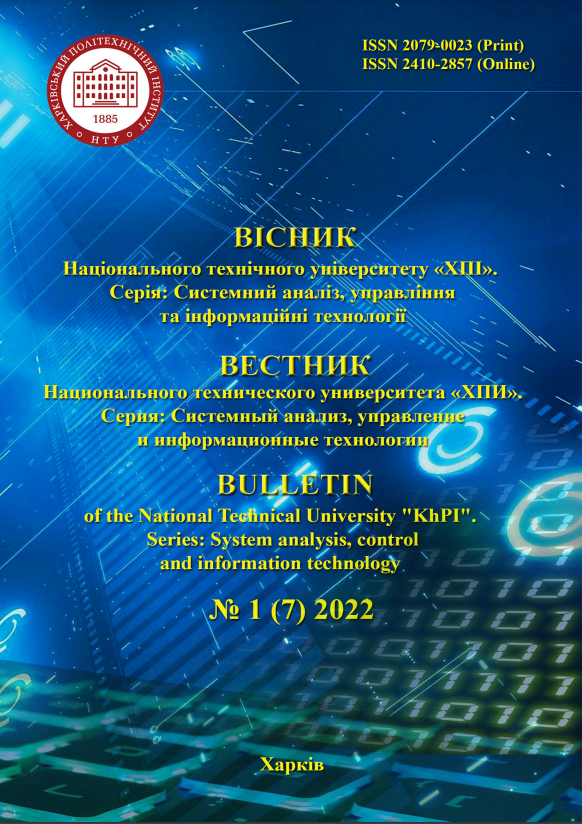SHOPPING MALL AIR PARAMETERS MEASUREMENT SYSTEM SYNTHESIS
DOI:
https://doi.org/10.20998/2079-0023.2022.01.05Keywords:
shopping mall, weather station, automated control, hardware and software complex, Arduino, thermal controlAbstract
The article is devoting to a shopping mall air parameters monitoring system creation. It is stated that increasing energy production, the world's population and harmful emissions into the atmosphere requires identifying solutions for searching and reducing the human activities impact on the environment. This issue is urgent because of the fact that environment harmful changes are irreversible. It is known that one of the options for harmful parameters values obtaining information is the construction and implementation of measurement systems, that are called weather stations. Literature review showed that available weather environment stations of temperature and humidity measuring only for the general purposes are designed. It limits the number of parameters that can be measured. The main parameters of the indoor environment that affect human health have been identified. It has been found that high concentrations of some gases can be dangerous for human health. It is shown that the issue of proper operation of the ventilation and air conditioning system and measuring its performance is an urgent task. The main requirements for the weather stations construction were obtained. Microcontroller and sensors synthesis for the weather station construction is made. The structural scheme and the scheme of connection of sensors are developed. The major attention is paid to the algorithms description that shows how air parameters system measurement works. The software system using the selected controller and sensors has been tested. A visualization of displaying the obtained shopping center air parameters has been developed. Based on received data the possibility of carrying out measurements on real object of management is confirmed.
References
Kreculj M. D., Nikolić V., Sajic J. L., Dihovični D., Kovačević N. R. The IoT Weather Station Model. Science and Higher Education in Function of Sustainable Development–SED 2021: 12th International Scientific Conference Science and Higher Education in Function of Sustainable Development, Užice, Serbia, 8/10/21. Available at: http://www.vpts.edu.rs/sed/fajlovi/inf/14.pdf (accessed 20.03.2022).
Dhungana B., Sharma M., Shrestha R. Digital Portable Weather Station Monitoring System Using Arduino Uno. Semiconductor Science and Information Devices. 2021, vol. 3, issue, 1, pp. 33–40.
Mestre G., Ruano A., Duarte H., Silva S., Khosravani H., Pesteh S., Ferreira P. M., Horta R. An Intelligent Weather Station. Sensors. 2015, vol. 15 (12), pp. 31005–31022. DOI:10.3390/s151229841.
Adepoju T. M., Oladele M. O., Kasali A. A., Fabiyi G. J. Development of a Low-Cost Arduino-Based Weather Station. FUOYE Journal of Engineering and Technology (FUOYEJET). 2020, vol. 5, issue 2, pp. 69–73.
Hussein Z. K., Hadi H. J., Abdul-Mutaleb M. R., Mezaal Y. S. Low cost smart weather station using Arduino and ZigBee. TELKOMNIKA Telecommunication, Computing, Electronics and Control. 2020, vol. 18, no. 1, pp. 282–288. DOI: 10.12928/TELKOMNIKA.v18i1.12784.
Essiane S. N., Essama B. G. O. Development of a micro weather station using Arduino and Internet of Things. Physics Education. 2022, vol. 57, issue 1, pp. 1–11. DOI: 10.1088/1361-6552/ac2670.
Hawkinson S. J., Madhumitha M., Raj A. S. Weather station update using renewable energy source. Journal of Xidian University. 2020, vol. 14, issue 5, pp. 4782–4792. DOI: 10.37896/jxu14.5/527.
Gheorghe A. C., Stoica C. I. Wireless weather station using arduino mega and arduino nano. Scientific Bulletin of the Electrical Engineering Faculty. 2021, no. 1, pp. 35–38. DOI: 10.2478/sbeef2021-0008.
Shahadat A. S. B., Ayon S. I., Khatun M. R. Efficient IoT based Weather Station. 2020 IEEE International Women in Engineering (WIE) Conference on Electrical and Computer Engineering (WIECON-ECE). Bangladesh, 2021, pp. 227–230. DOI: 10.1109/WIECON-ECE52138.2020.9398041.
Yunus M. A., Ibrahim S., Kaman K. K., Anuar N. H. K., Othman N., Majid M. A., Muhamad N. A. Internet of Things (IoT) Application in Meliponiculture. International Journal of Integrated Engineering – Special Issue on Electrical Electronic Engineering. 2017, vol. 9, no. 4, pp. 57–63.
Haavashja T., Nylander, P. Puhakka L. A compact road weather station. 30th International Baltic Road Conference (IBRC 2021). Riga, Latvia, 2021, pp. 1–6. DOI:10.1088/1757- 899X/1202/1/012037.
Suparta W., Warsita A., Ircham I. A low-cost development of automatic weather station based on Arduino for monitoring precipitable water vapor. Indonesian Journal of Electrical Engineering and Computer Sciences. 2021, vol. 24, no. 21, pp. 744– 753. DOI: 10.11591/ijeecs.v24.i2.pp744-753.
Aziz S., Hesham N., Elfiky D. Design and implement a real time weather station using Arduino and lab-View. Cairo, NARSS Publ., 2021. 2 p. (Preprint. National Authority for Remote Sensing and Space Science).
Downloads
Published
How to Cite
Issue
Section
License
LicenseAuthors who publish with this journal agree to the following terms:
- Authors retain copyright and grant the journal right of first publication with the work simultaneously licensed under a Creative Commons Attribution License that allows others to share the work with an acknowledgement of the work's authorship and initial publication in this journal.
- Authors are able to enter into separate, additional contractual arrangements for the non-exclusive distribution of the journal's published version of the work (e.g., post it to an institutional repository or publish it in a book), with an acknowledgement of its initial publication in this journal.
- Authors are permitted and encouraged to post their work online (e.g., in institutional repositories or on their website) prior to and during the submission process, as it can lead to productive exchanges, as well as earlier and greater citation of published work (See The Effect of Open Access).


